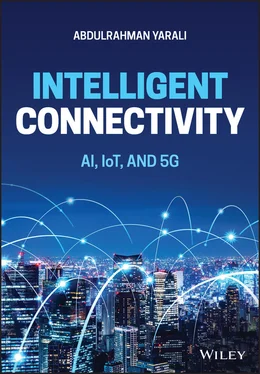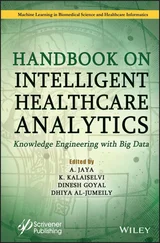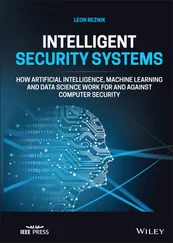Finally, smartphones play a key role in humans' intellectual connectivity lives. Smartphones are forecast to account for four of every five connections by 2025, up from 65% in 2019. The rise of many digital assistants, such as Amazon Alexa, has not demised smartphones with their basic functions, expected to be improved continuously and comprehensively to continue to strengthen their key role in the 5G and the IoT ecosystem.
The world of AI, 5G data networks, and the rapidly growing IoT devices can be very helpful but may present numerous flaws as they are all new and rapidly developing technologies. It is important to note that the 5G network has better security than the 3G and 4G networks. Still, it has been said that some of the classic vulnerabilities and security flaws from 3G and 4G networks were directly carried over to the developing 5G network, thus presenting additional security flaws right out of the gate. Both AI and the IoT will benefit from the development of 5G networks where businesses can use such devices, which will be tied to the growing 5G network, and can serve several purposes throughout the business market, among other areas.
In this book, the chapters cover the fusion of AI, IoT, 5G, Blockchain technologies, and the cutting‐edge applications that cater to customers' personalized needs, very lucrative for businesses who want to reap the many benefits from a line of intelligent products or intelligent services.
We are very pleased that the technology, academic, and industry communities discuss this important and fast‐growing industry. We are certain that this book's content will shed some light on this subject. The chapters presented in this book discuss technologies, design, implementation, AI applications, IoT, and 5G. The challenges and issues faced in providing applications and services to meet user experiences ubiquitously and securely are presented.
I would like to express my gratitude to all those who provided support and discussions, talked things over, read, wrote, offered comments, allowed me to quote their remarks and assisted in the editing and proofreading. I would like to give special thanks to all my graduate and undergraduate students in CNM302, CNM320, CNM322, CNM323, CNM397, CNM421, and CNM571 classes of our distinction program of Cybersecurity and Network Management at Murray State University, Kentucky. This book would never have found its way to the publisher without these students.
Abdulrahman Yarali
Introduction
Intelligent Connectivity: Fusion of AI, IoT, and 5G
Operations are revolutionized by information technology through smart connected products that help in device miniaturization and by processing power and wireless connectivity. Smart connected products provide greater reliability, expanding opportunities, and much high utilization of the product and its capabilities of transcending traditional products. It involves strategic choices of creating and capturing products, newly generated data, and relationship with conventional business partners.
Intelligent connectivity is essentially the combination of high‐speed fifth generation (5G) networks, Artificial Intelligence (AI), and the Internet of Things (IoT). Combining these technologies results in structural changes about how devices communicate by improving both the performance and efficiency to pave the road for Digital Transformations. The analysis and vision in this intelligent connectivity are processed through the digital transformation of the data collected by sensing devices, machines, and the IoT. Intelligent connectivity is much more than just faster and more efficient communications. It opens up a whole world of personalized and ambitious applications very lucrative for businesses who want to reap the many benefits from a line of intelligent products or intelligent services. While there are many areas in which consumers would see substantial benefits from using intelligent connectivity, Entertainment, Workplace Productivity, and Smart Living have been the groups with substantial benefits. Through a fusion of these advanced technologies, it would be possible to create or enhance technologies that can provide a better quality of life, better security and public safety, and significantly greater efficiency to almost any industry, making the fifth wave of computing.
Intelligent connectivity will significantly impact industry, individuals, and society. This phenomenon will significantly impact people, industries, governments, and organizations, transforming our way of life and work, marking the beginning of a new digital era defined by highly contextualized and personalized experiences. Augmented and virtual reality will change the way we watch live sports and music concerts, drones will deliver packages to our homes, and virtual personal assistants will manage our lives for us. New 5G networks, AI, and the upscaling of the IoT will change the world, intelligently connecting everyone and everything to a better future. The fusion of AI, IoT, and 5G will drastically improve the network capacity, responsiveness, and output. It will make it possible for the operators to tailor the connectivity of each application, hence increasing the application of AI, data analytics, and regulating the IoT.
1 Technology Adoption and Emerging Trends
1.1 Introduction
In the last few decades, the world has been changing at a faster rate than before. The immense growth in the global network has left billions of people hyper‐connected to each other. Thus, there has been tremendous growth and spread of new ideas and technological innovations (Desjardins 2018). Due to different technological trends, changes in high‐tech advances, and demographics, it is expected that the next two decades will experience an exponential and historic transformation (Bayern 2019). The advancement of networking and serverless computing is expected to reshape all the business processes in the next few years. Even though technology has been disrupting different industries, it will reshape gradually in the coming decades since players have been forced to integrate technological advances in their businesses (Arnold and Shadnam 2014). New technologies and scientific breakthroughs have been paraded since they are relentless, and they continue to unfold. Technological advancements are achieved every day, and thus it is expected that they will continue to disrupt people, businesses, and the world at large. Policymakers and different societies need to prepare for technology's future since it is expected that our economy's current status quo will keep changing in the coming years. Ad technology continues to grow so the government should create an environment where citizens will continue to prosper even after different emerging technologies disrupt people's lives and businesses (Bayern 2019). In today's world, we are in the middle of the business revolution, where technology is transforming different business entities. Different businesses will continue to focus on different core technological trends such as mobility, cloud computing, and big data (UN 2018).
In the last few years, there has been a proliferation and convergence of mobile networks, devices, applications, and operating systems. Thus, most businesses around the world are willing to take advantage of and expand their mobile technology (Arnold and Shadnam 2014). As a result, the consumerization of Information Technology (IT) devices and trends in BYOD (Buy Your Own Device) has enabled people to use their devices to work while in motion; this has led to an increase in employee's productivity since they can respond to all the market changes and embrace all the opportunities that might arise. The emergence of mobility as a business tech model has played a significant role in reducing equipment costs and has provided the employees with a sense of employment (Desjardins 2018). They have the freedom to work from any location, and they have an increased level of accessing information. Therefore, employees in different business entities can perform more tasks outside their offices than before. The emergence of big data is expected to change business dynamics in various organizations. In the next two decades, the volume of data available to different enterprises will grow dramatically (Kambala 2018). Big data is expected to change insights about the customers, operational costs, and all the relevant aspects of different business models worldwide. The emergence of cloud computing has enabled businesses to compete at a higher level since the traditional software and systems are no longer required. In the next two decades, cloud computing is expected to grow at a higher level since organizations will focus on business models that they can use to reduce operational costs. In today's world, cloud technology enables organizations to segment and use diverse resources easily and at a lower cost. It has also enabled the implementation of high‐performing infrastructures that can be accessed by using mobile devices, and thus they have had widespread adoption.
Читать дальше












